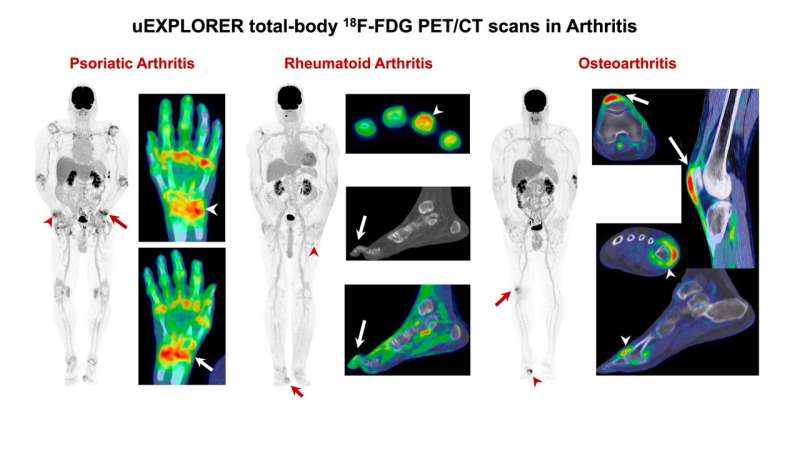Total-body PET/CT captures full picture of systemic inflammatory arthritis

For the first time, physicians can examine the systemic burden of inflammatory arthritis simultaneously across all joints and organ systems, using the high-sensitivity, high-resolution uEXPLORER total-body positron emission tomography/computed tomography (TB-PET/CT) scanner. Results of the first in-human TB-PET/CT scans conducted in the arthritic population were presented at the Society of Nuclear Medicine and Molecular Imaging 2020 Virtual Annual Meeting.
Inflammatory arthritic conditions, such as rheumatoid arthritis or psoriatic arthritis, are considered systemic disorders, affecting the whole body. Yet current evaluation—mostly via anatomical imaging, such as X-ray or CT imaging—is conducted for only a few joints of the body, such as those of the wrist and hand. In the past, 18F-FDG PET scans have been used infrequently in this population due to spatial resolution and sensitivity limitations as well as radiation dose concerns.
The total-body coverage, high resolution and high sensitivity of the TB-PET/CT scanner, however, offers new imaging options for inflammatory arthritis. "In our research, we sought to examine the feasibility of assessing glucose metabolism both in normal and diseased joint tissues across the body as a means for quantifying systemic inflammatory burden for these conditions," stated Yasser Abdelhafez, MBBCh, MSc, MD, FEBNM, a postdoctoral researcher in Abhijit Chaudhari's laboratory at the University of California, Davis, in Sacramento, California.
The ongoing, prospective study enrolled 14 participants with established rheumatoid arthritis, psoriatic arthritis or osteoarthritis who underwent a single-timepoint TB-PET/CT scan for 20 minutes. The participants received an injection of 75.5 MBq of 18F-FDG, which is approximately 20 percent of the conventional 18F-FDG dose. Qualitative findings and different patterns for the three conditions were analyzed.
Participants with rheumatoid arthritis showed multiple, rather symmetric joint involvement, most commonly in the hands; joints of the feet appeared to be less frequently affected. Other notable features of this group included radiotracer uptake patterns consistent with inflammation of the joint synovium. All participants with psoriatic arthritis had positive findings in large joints and demonstrated multiple sites of enthesitis (inflammation where a tendon or ligament attached to a bone), which affected the tendons of the hand and fingers, including the nail beds. Osteoarthritic participants showed unilateral enhanced FDG uptake in at least one large joint (shoulder, elbow or knee), and occasionally in a few small joints of the hand and feet and the quadriceps femoris tendon.
"Systemic joint evaluation of patients with inflammatory arthritis is indeed feasible with this TB-PET/CT scanner, and feasible with low radiation dose," stated Abdelhafez. "The evaluation of arthritic disease activity at all joints of the body could have direct implications for disease staging, risk stratification, treatment selection and monitoring of treatment response. Furthermore, the impact of arthritis on other tissues of the body can be studied to better understand systemic disease burden."
He continued, "Total-body molecular imaging could provide currently unavailable, systemic, objective biomarkers that could help address the significant clinical challenges in managing inflammatory arthritic populations. These biomarkers may also have clear potential to accelerate arthritic drug discovery and development."




















